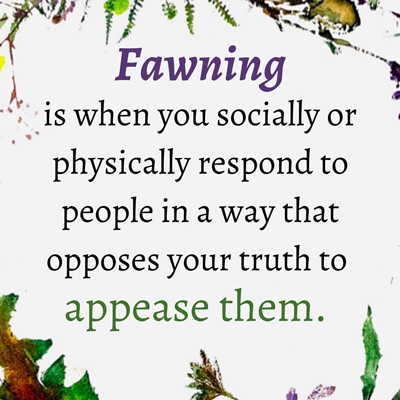Estimated reading time: 4 minutes
Exposing the often overlooked 4th trauma response and taking down our learned behaviors that satisfy the needs of others but abandon our own
—
We’ve all heard about fight, flight & freeze. These are trauma responses — the automatic responses from your body when you experience threat. They are all self-explanatory, but what about the fourth response? One so insidious and societally acceptable (even rewarded), that we barely even talk about it or notice it’s there?
This fourth response is known as ‘fawning’.
Fawning is when we appease, people please, pretend we are happy when we’re not, and even consent to things we don’t really want in order to mollify the emotions of others around us.
Fawning is widely displayed and, innocently, taught. We teach our children to fawn by saying “smile” when they don’t want to. We make them stay still when they want to move and we tell them to let people hug them when they don’t want to be touched. All because it makes the other person feel better.
This is different from having and teaching manners. Manners are a respectful way to say “I see you.” We might teach our children to say “thank you” or “I’m sorry I bumped into you,” but do we teach them how to respect and see themselves? Do we teach them to tell someone “I don’t like the way you touched me,” or “I feel stressed when you speak to me like this?” Do we teach them to listen to their bodies or to what someone else wants their body to do?
We teach our children to fawn because we fawn.
Yes, we get stressed when other people are uncomfortable, so we make our children act in ways that keep other people comfortable as well. It’s in those moments of “hug your uncle” when they don’t want to that we teach them to override their intuition and boundaries in those moments. They learn that, by repressing their own feelings, they’re sparing someone else’s disappointment or embarrassment.
And then we call it “nice”. So we grow up being valued for being “nice” (or bypassing our feelings) and then we meet someone who takes advantage of us and we let them — because we’re nice and we’ve grown accustomed to this behavior.
The shadow of fawning is deep resentment and aggression. I’ve sat with many people who use this strategy and, when given the opportunity to feel how they really feel, a lot of hatred and even violence emerges. This is just the necessary swing of the pendulum. Every fawning moment is a boundary break. Resentment and aggression exists to protect those boundaries. When we stop fawning, we also stop being angry.
I experience fawning and the teaching of fawning as an innocent one because it’s completely unconscious and it stems from intergenerational trauma. At some point in your life, or your ancestor’s lives, speaking or being your truth was threatening. That information stays in your cells until it get released. The information being: your truth = threat.
So we unconsciously live from the fawn response, consistently monitoring and modulating our truths so that we can feel safe. It’s a fear response and it’s taught, not through language, but through behaviors.
We release this unconscious response by making it conscious. You can do this right now. Just ask yourself: when do I smile, say yes, or act interested when I don’t want to? What does it feel like in my body when I do that? Would I actually be threatened if I stopped, or would it only feel like that?
This is the beginning. Notice how it feels, where it happens, how you fawn, and then you’re on the road to recovery. I strongly recommend working with a Somatic Experiencing therapist who can help you embody these responses so you can better notice when they happen and then redirect them.
You may also enjoy reading The Sacred Pause: The Art of Activating Healing Energy, by Travis Eliot

